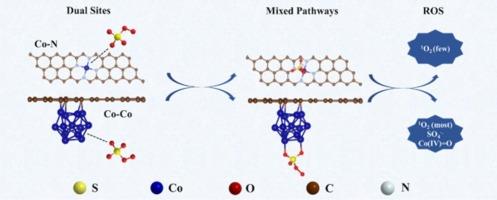碳纳米管催化剂中Co-Co/Co-N活性位点的工程设计用于高效类芬顿去除磺胺甲恶唑
IF 9
1区 工程技术
Q1 ENGINEERING, CHEMICAL
引用次数: 0
摘要
开发高效稳定的载碳钴基催化剂对类fenton废水净化具有重要意义。在碳底物中加入N原子可以有效地调节催化剂的电荷分布并产生多个活性位点。本文以ZIF-9和三聚氰胺为前驱体,构建了Co纳米颗粒包封n掺杂碳纳米管(Co@NCNT)。在类芬顿催化中,Co@NCNT能高效激活过氧单硫酸根(PMS)产生活性氧(ROS),并在5 min内完全降解磺胺甲恶唑(SMX)。同时,Co@NCNT/PMS体系对无机阴离子和天然有机物具有良好的抗性,对各种有机污染物具有很强的适应性。SMX降解连续10 h运行表明Co@NCNT具有良好的循环稳定性和实际应用潜力。机理分析表明自由基(SO4•-)与非自由基(1O2, Co(IV) = O)之间存在协同作用。此外,有两个活性位点(Co-Co/Co- n)促进PMS活化,CoCo键主要促进形成1O2, Co(IV) = O和SO4•-,而CoN键产生少量的1O2,减少Co泄漏,提高电子传递效率。总之,这项工作为简单制造具有双活性位点的高效类芬顿催化催化剂提供了一种策略。本文章由计算机程序翻译,如有差异,请以英文原文为准。

Engineering active Co-Co/Co-N sites in carbon nanotube catalyst for efficient Fenton-like removal of sulfamethoxazole
Development highly efficient and stable carbon-loaded cobalt-based catalysts holds great significance for Fenton-like wastewater purification. The incorporation of N atoms into the carbon substrate can effectively modulate the charge distribution of the catalyst and generate multiple active sites. Herein, using ZIF-9 and melamine as precursors, Co nanoparticles encapsulated N-doped carbon nanotubes (Co@NCNT) were constructed. In Fenton-like catalysis, Co@NCNT could efficiently activate peroxymonosulfate (PMS) to produce reactive oxygen species (ROS), and completely degrade sulfamethoxazole (SMX) within 5 min. Meanwhile, the Co@NCNT/PMS system shows good resistance to inorganic anions and natural organic matter and is highly adaptable to various organic pollutants. Continuous 10 h operation of SMX degradation indicates Co@NCNT has good cycling stability and practical application potential. Mechanism analysis reveals the synergistic effect between radicals (SO4•-) and non-radicals (1O2, Co(IV) = O). In addition, there are two active sites (Co-Co/Co-N) to propel PMS activation, Co Co bonds primarily contribute to the formation of 1O2, Co(IV) = O, and SO4•-, whereas Co
Co bonds primarily contribute to the formation of 1O2, Co(IV) = O, and SO4•-, whereas Co N bonds generate a minor amount of 1O2, minimize Co leakage, and enhance electron transfer efficiency. In summary, this work provides a strategy for the simple fabrication of catalysts with dual active sites for efficient Fenton-like catalysis.
N bonds generate a minor amount of 1O2, minimize Co leakage, and enhance electron transfer efficiency. In summary, this work provides a strategy for the simple fabrication of catalysts with dual active sites for efficient Fenton-like catalysis.
 Co bonds primarily contribute to the formation of 1O2, Co(IV) = O, and SO4•-, whereas Co
Co bonds primarily contribute to the formation of 1O2, Co(IV) = O, and SO4•-, whereas Co N bonds generate a minor amount of 1O2, minimize Co leakage, and enhance electron transfer efficiency. In summary, this work provides a strategy for the simple fabrication of catalysts with dual active sites for efficient Fenton-like catalysis.
N bonds generate a minor amount of 1O2, minimize Co leakage, and enhance electron transfer efficiency. In summary, this work provides a strategy for the simple fabrication of catalysts with dual active sites for efficient Fenton-like catalysis.
求助全文
通过发布文献求助,成功后即可免费获取论文全文。
去求助
来源期刊

Separation and Purification Technology
工程技术-工程:化工
CiteScore
14.00
自引率
12.80%
发文量
2347
审稿时长
43 days
期刊介绍:
Separation and Purification Technology is a premier journal committed to sharing innovative methods for separation and purification in chemical and environmental engineering, encompassing both homogeneous solutions and heterogeneous mixtures. Our scope includes the separation and/or purification of liquids, vapors, and gases, as well as carbon capture and separation techniques. However, it's important to note that methods solely intended for analytical purposes are not within the scope of the journal. Additionally, disciplines such as soil science, polymer science, and metallurgy fall outside the purview of Separation and Purification Technology. Join us in advancing the field of separation and purification methods for sustainable solutions in chemical and environmental engineering.
 求助内容:
求助内容: 应助结果提醒方式:
应助结果提醒方式:


